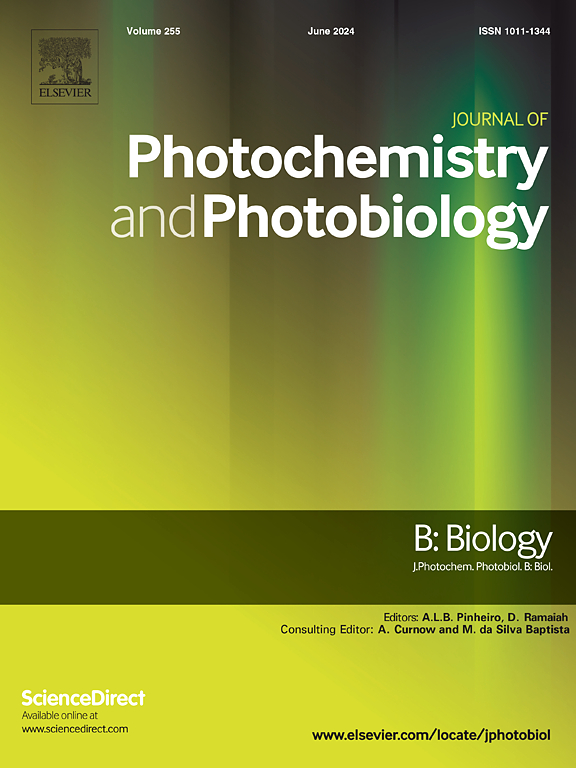Light-activated Zein–curcumin films for the photodynamic inactivation of bacterial biofilms: Continuous vs. intermittent illumination
IF 3.7
2区 生物学
Q2 BIOCHEMISTRY & MOLECULAR BIOLOGY
Journal of photochemistry and photobiology. B, Biology
Pub Date : 2025-09-19
DOI:10.1016/j.jphotobiol.2025.113270
引用次数: 0
Abstract
The development of protein-based films derived from plants and agricultural sources has gained significant attention in the medical and food industries due to their broad applicability, sustainability, low cost, and non-toxic nature. Over the years, numerous studies have reported (photo)antimicrobial films aligned with the principles of the circular economy. In this study, zein-based films immobilized with curcumin as a photosensitizer (2.5 % and 5 % w/w) were synthesized and fully characterized using UV–Vis spectroscopy, fluorescence analysis, FT-IR, thermogravimetry (TG), and water contact angle measurements. Their potential for photodynamic applications was assessed through photobleaching analysis, confirming the generation of reactive oxygen species (ROS) at both concentrations. Furthermore, microbiological evaluations were conducted against Staphylococcus aureus biofilms under two different lighting regimes: continuous and intermittent exposure at specific time intervals (0, 6, 12, 18, and 24 h). The films demonstrated promising antimicrobial activity, achieving bacterial inactivation of up to 3.5 log reductions. These findings highlight the potential applications of zein-curcumin films as coatings for medical devices (e.g., endotracheal tubes, catheters) and as sustainable food packaging materials. The incorporation of photoantimicrobial properties into biodegradable films opens new perspectives for their use in healthcare and food preservation.

用于细菌生物膜光动力失活的光活化玉米素-姜黄素薄膜:连续与间歇照明
基于植物和农业来源的蛋白质薄膜的开发由于其广泛的适用性、可持续性、低成本和无毒性而在医疗和食品工业中受到了极大的关注。多年来,许多研究报告(图)抗菌膜符合循环经济的原则。本研究合成了以姜黄素为光敏剂(2.5%和5% w/w)固定的玉米蛋白基薄膜,并利用紫外可见光谱、荧光分析、红外光谱、热重(TG)和水接触角测量对其进行了全面表征。通过光漂白分析评估了它们的光动力学应用潜力,确认了两种浓度下活性氧(ROS)的产生。此外,在两种不同的光照条件下,对金黄色葡萄球菌生物膜进行了微生物学评估:在特定的时间间隔(0、6、12、18和24小时)连续照射和间歇照射。该薄膜表现出了良好的抗菌活性,实现了高达3.5 log的细菌灭活。这些发现突出了玉米素-姜黄素薄膜作为医疗器械涂层(例如,气管内管,导管)和可持续食品包装材料的潜在应用。将光抗菌特性纳入可生物降解薄膜为其在医疗保健和食品保存中的应用开辟了新的前景。
本文章由计算机程序翻译,如有差异,请以英文原文为准。
求助全文
约1分钟内获得全文
求助全文
来源期刊
CiteScore
12.10
自引率
1.90%
发文量
161
审稿时长
37 days
期刊介绍:
The Journal of Photochemistry and Photobiology B: Biology provides a forum for the publication of papers relating to the various aspects of photobiology, as well as a means for communication in this multidisciplinary field.
The scope includes:
- Bioluminescence
- Chronobiology
- DNA repair
- Environmental photobiology
- Nanotechnology in photobiology
- Photocarcinogenesis
- Photochemistry of biomolecules
- Photodynamic therapy
- Photomedicine
- Photomorphogenesis
- Photomovement
- Photoreception
- Photosensitization
- Photosynthesis
- Phototechnology
- Spectroscopy of biological systems
- UV and visible radiation effects and vision.

 求助内容:
求助内容: 应助结果提醒方式:
应助结果提醒方式:


